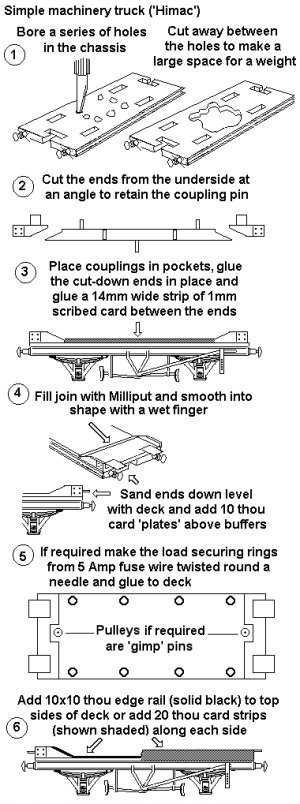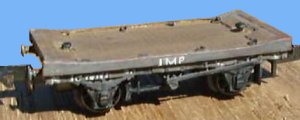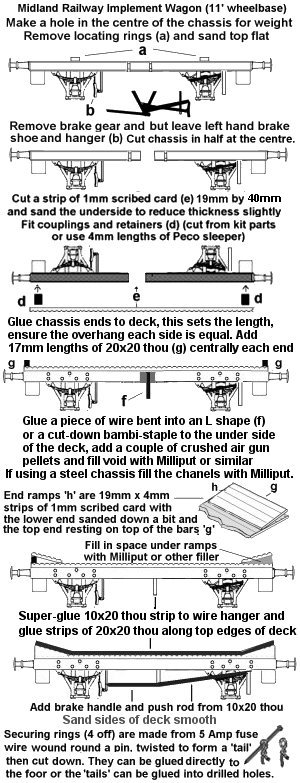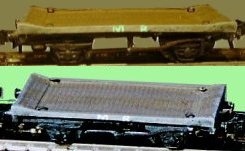There has been a demand to agricultural equipment and other wheeled vehicles on the railways since the Liverpool and Manchester line opened in 1830, the wagons used were called either implement wagons or machinery trucks. To allow the carriage of tall vehicles and equipment many of the wagons used had small wheels and a dropped centre but some had only a shallow dip in the centre of the wagon. The 'high machinery truck' or 'himac' is an easy option for adding interest to a goods rake as it does not require any major surgery to the chassis. The early furniture vans were transported on 1 plank or flat wagons, to fit within the loading gauge they had to have their wheels removed and were craned on and off the wagons. To cater for this traffic drop-centre wagons were built, allowing vans to be loaded and unloaded in an end loading dock, without having their wheels removed.
The information is presented as a set of pictures, these will take a while to download, to save any one of these right click on the required picture and select 'save picture as'. The pictures can then easily be printed for reference.
Simple machinery truck from a Peco single bolster wagon kit. This is the most basic approach to providing a simple 'drop centre' wagon model, the centre is not actually dropped as the flanges on N Gauge wheels prevent this. This is not a model of a specific prototype but serves well enough as a generic wagon, suitable for layouts set from the 1920s to the 1960s. The number of securing rings is optional, one in each corner, three or four to a side. The pulleys on the ends are also optional, not all wagons had these (they allowed a horse to pull the load onto the wagon by looping a rope over the pulley at the far end).  My model is supposed to be an LNER implement truck, coded 'IMP'. The chassis is a Peco 10 foot wheelbase wooden type with the right hand brake shoe and push rod removed and the sides have been scraped down to leave a small rail at each side of the floor.  |
LNWR furniture van truck using a Peco ten foot wheelbase chassis. The prototype had a dropped floor and small wheels, the buffers being mounted in line with the upper headstocks, but this model looks acceptably low compared to (for example) a Peco single bolster wagon. The drawings on which the model was based did not show any form of drop-flap or metal hood over the buffers, which every other wagon of this type seemed to have, my drawing is as per the original drawing.  |
CLC 6 wheeled furniture van truck, also I believe used for other heavy vehicles. I have very little information on this wagon, I do not know if it was classed as 'passenger stock' (which seems unlikely but possible) or as goods stock. However it looks pleasantly different and adds interest to a rake of wagons set in the period 1910 to about 1950. The drawing on which the model is based contained little information, I made a sketch to work from which contains all the information I had found.  No brake gear is shown on the original drawing, I opted to retain the inner brake shoes on the outer wheels.  My model was made for my god son's layout and has full-height sides as I thought this would be better able to retain a removable load, it is also easier to letter. The model is painted in CLC goods livery.  |
The Midland Railway and S&DJR (and also the LSWR I believe, some ended up as SR stock) had some long wheelbase implement trucks, used mainly for farm machinery. These had a twenty foot body running on an eleven foot six inch wheelbase with a central rod type brake hanger (one brake shoe on the left hand wheel) and four heavy securing rings at the sides of the deck. This MR type can be represented by extending the Peco chassis by 4mm, this small extension in length does actually show up clearly when the wagon is in a rake. Suitable for layouts from about 1890 to the 1950s, possibly the early 1960s. There is a photo of the type in S&DJR livery in Southern Wagons Volume 1 (see bibliography) My model has a floor 19mm wide to accommodate a cast white metal 'cultivator' (a wheeled farm implement) from the W&T range.  The 5 Amp fuse wire load securing rings can be glued into holes or they can be trimmed and glued direct to the deck. If you plan to add a permanent load, attached to the rings, they need tails glued into holes, and the load needs to be secured to the wagon floor as well. For a heavy (white metal) load drill small holes through the deck and chassis and add wire, twisted and glued underneath as well as gluing the load down. |
Simple furniture van load. This model was made many years ago to run on the CLC six wheeled truck shown above, the livery was printed onto paper and glued to the body and has survived a lot of handling and being in an unheated outhouse for several years. When I built this model it was intended to replace it with a more detailed version, hence I did not add the short stubs to either side of the main longitudinal's, however the model proved popular and was never replaced. As built it has a hole in the central towing bracket and I supplied a pair of horses with the shaft on the end of which a 5 Amp fusewire (coated in solder)hook would engage with the hole. Side traces of similar wire also had hooks on the ends which could engage in the side rings - In practice the van stayed on the wagon and the horses were eventually re-assigned, but it proved it can be done if required.
 | |